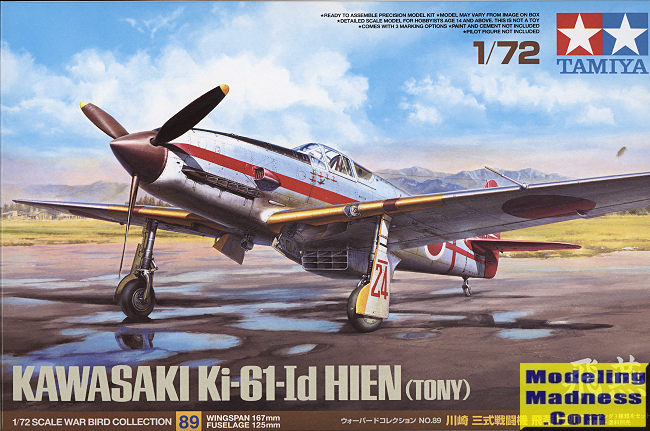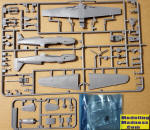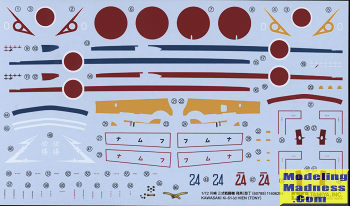
Tamiya 1/72 Ki-61-Id Hien
| KIT #: | 60789 |
| PRICE: | 1600 yen SRP |
| DECALS: | Three options |
| REVIEWER: | Scott Van Aken |
| NOTES: | 2018 tooling |

| HISTORY |
The first prototype of the San-shiki-Sentohki ichi gata ("Type 3 Fighter, Model 1", the official IJAAF designation) first flew in December 1941 at Kagamigahara Airfield. Although test pilots were enthusiastic about its self-sealing fuel tanks, upgraded armament, and good dive performance, the wing loading of 146.3 kg/m² (30 lb/ft²) at an all-up weight of 2,950 kg (6,500 lb) was viewed with skepticism by many of the senior officers of the Koku Hombu, who still believed in the light, highly manoeuvrable, lightly armed fighter epitomised by the then new Nakajima Ki-43-I-Hei which had a wing loading of 92.6 kg/m² (19 lb/ft²) (and even that was considered borderline compared to the earlier Ki-27).
To address these concerns, Kawasaki staged a fly-off between two Ki-61 prototypes and the Nakajima Ki-43-I, a pre-production Nakajima Ki-44-I, a Lavochkin-Gorbunov-Goudkov LaGG-3 (flown to Manchuria by a defector), a Messerschmitt Bf 109E-3, and a captured Curtiss P-40E Warhawk. The Ki-61 proved the fastest of all the aircraft and was inferior only to the Ki-43 in manoeuvrability.
The Ki-61 was the last of the fighters powered by the DB-601 or its foreign derivatives, and it was soon overshadowed by fighters with more powerful engines. By the time it first flew in December 1941, one year after the Macchi C.202's first flight and three years after the first Bf 109E, the engine was already underpowered compared to the new 1,120 kW (1,500 hp) inline or 1,491 kW (2,000 hp) radial engines being developed (and already nearing the mass-production stage) to power the next generation of combat aircraft such as the Republic P-47 Thunderbolt. Moreover, the inline Ha-40 engine proved to be an unreliable powerplant.
The DB-601 engine required precise and sophisticated manufacturing; the Ha-40 was lighter by roughly 30 kg (70 lb) and required even higher manufacturing standards. Reaching these standards proved difficult for Japanese manufacturers, an issue further complicated by the variable quality of materials, fuel, and the lubricants needed to run a sensitive, high-performance engine. The Japanese equivalent of the more powerful DB-605 engine was the Ha-140, which was fitted onto the Type 3 to produce the Ki-61-II high-altitude interceptor.
Ki-61-I-Tei Fighter variant (this kit) had two Japanese 20 mm Ho-5 cannon in the wings and two synchronized 12.7 mm (.50 in) Ho-103 machine guns above the engine. The Tamiya history states that the cannon were located in the nose requiring a 20cm lengthening of the forward fuselage.
| THE KIT |
 Whenever
Tamiya produces a 1/48 kit, we hope that we will see it in 1/72 as well. They
have not disappointed, providing us with a very nice kit of the long nose -Id.
While I would guess that others (Fine Molds or RS perhaps) have done this
version in this scale, this one should prove the be the best of the group.
Whenever
Tamiya produces a 1/48 kit, we hope that we will see it in 1/72 as well. They
have not disappointed, providing us with a very nice kit of the long nose -Id.
While I would guess that others (Fine Molds or RS perhaps) have done this
version in this scale, this one should prove the be the best of the group.
The engineering is all we could hope for and the detailing is superb. The cockpit builds up into a nicely done tub with all the appropriate knobs and levers. Not only that, but these are done in clusters rather than a myriad of individual parts. In line with their previous kit, there are no pins and sockets, but large alignment tabs to hold some of the major pieces (like the fuselage halves) in place. This kit repeats the larger scale one by having the upper fuselage spine as a separate part that is integrated with the area behind the cockpit.
Wings are a single lower section with the control surfaces and wing tips built into the upper halves. Once the fuselage is together, you install the wing by inserting a tab into the rear join and sliding the forward section in place. No rear fuselage step. You are also provided with a nicely done radiator bath, complete with the large forward grille. Landing gear are very nicely done and the tail wheel/leg is integrated with a small section of lower fuselage. The canopy is a single piece but very clear so you will see the interior work. The kit provides optional radio masts and while some may wish for the under wing pylons and tanks, I don't miss them. I'm sure the aftermarket folks will take care of that. One will also need to do some filling or hole opening depending on which of the three options they choose.
 There are
markings for three aircraft. One is the box art plane in overall natural metal
with a red fin and tailplanes. This was flown by Teruhiko Kobayashi of the 244
Sentai in early 1945. Another in natural metal with lots of upper surface
mottles was flown by Shunzo Takashima, also of the 244 Sentai, but this time a
bit later in the year. It has blue striping but the red tail. Finally one where
all the upper surfaces have been painted green from the 19th Sentai based in the
Philippines during late 1944. You are provided with two different colors of the
fin marking on this one as it is apparently difficult to tell the exact shade.
Decals are superbly done and include not only stencils but also the yellow ID
bands for the wing leading edge.
There are
markings for three aircraft. One is the box art plane in overall natural metal
with a red fin and tailplanes. This was flown by Teruhiko Kobayashi of the 244
Sentai in early 1945. Another in natural metal with lots of upper surface
mottles was flown by Shunzo Takashima, also of the 244 Sentai, but this time a
bit later in the year. It has blue striping but the red tail. Finally one where
all the upper surfaces have been painted green from the 19th Sentai based in the
Philippines during late 1944. You are provided with two different colors of the
fin marking on this one as it is apparently difficult to tell the exact shade.
Decals are superbly done and include not only stencils but also the yellow ID
bands for the wing leading edge.
| CONCLUSIONS |
I am delighted to see this being done. The previous kits of the Ki-61, while not bad builds, were generally a tad fussy. This one should not be and will probably be a fairly quick construct.
| REFERENCES |
https://en.wikipedia.org/wiki/Kawasaki_Ki-61
April 2018
Copyright ModelingMadness.com. All rights reserved.
If you would like your product reviewed fairly and fairly quickly, please contact the editor or see other details in the Note to Contributors.